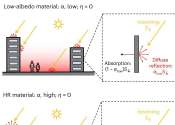In physics, temperature is a physical property of a system that underlies the common notions of hot and cold; something that feels hotter generally has the higher temperature. Temperature is one of the principal parameters of thermodynamics. If no heat flow occurs between two objects, the objects have the same temperature; otherwise heat flows from the hotter object to the colder object. This is the content of the zeroth law of thermodynamics. On the microscopic scale, temperature can be defined as the average energy in each degree of freedom in the particles in a system. Because temperature is a statistical property, a system must contain a few particles for the question as to its temperature to make any sense. For a solid, this energy is found in the vibrations of its atoms about their equilibrium positions. In an ideal monatomic gas, energy is found in the translational motions of the particles; with molecular gases, vibrational and rotational motions also provide thermodynamic degrees of freedom.
Temperature is measured with thermometers that may be calibrated to a variety of temperature scales. In most of the world (except for Belize, Myanmar, Liberia and the United States), the Celsius scale is used for most temperature measuring purposes. The entire scientific world (these countries included) measures temperature using the Celsius scale and thermodynamic temperature using the Kelvin scale, which is just the Celsius scale shifted downwards so that 0 K= −273.15 °C, or absolute zero. Many engineering fields in the U.S., notably high-tech and US federal specifications (civil and military), also use the kelvin and degrees Celsius scales. Other engineering fields in the U.S. also rely upon the Rankine scale (a shifted Fahrenheit scale) when working in thermodynamic-related disciplines such as combustion.






